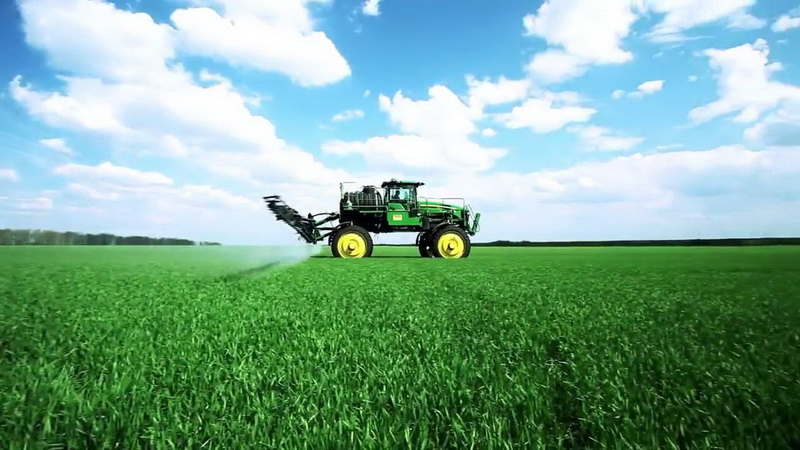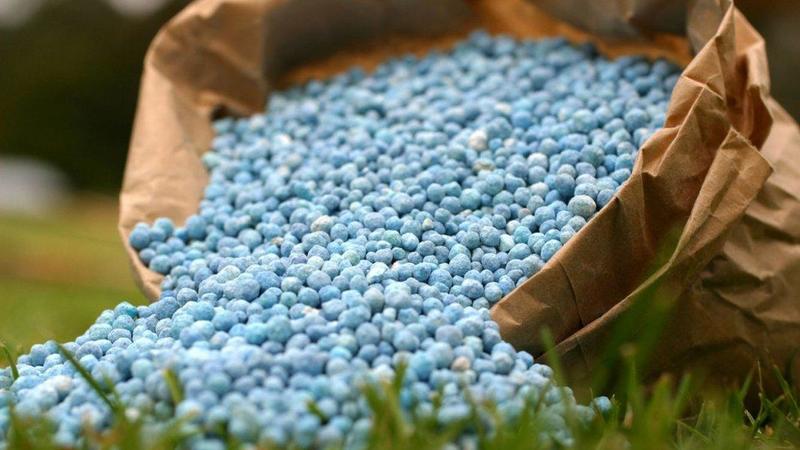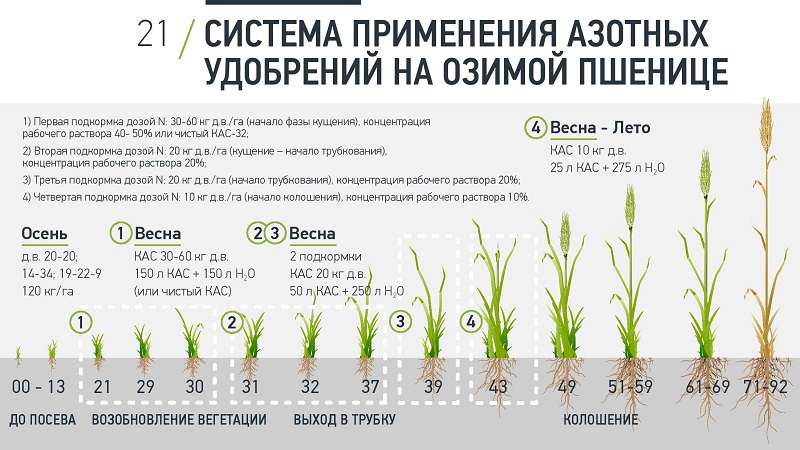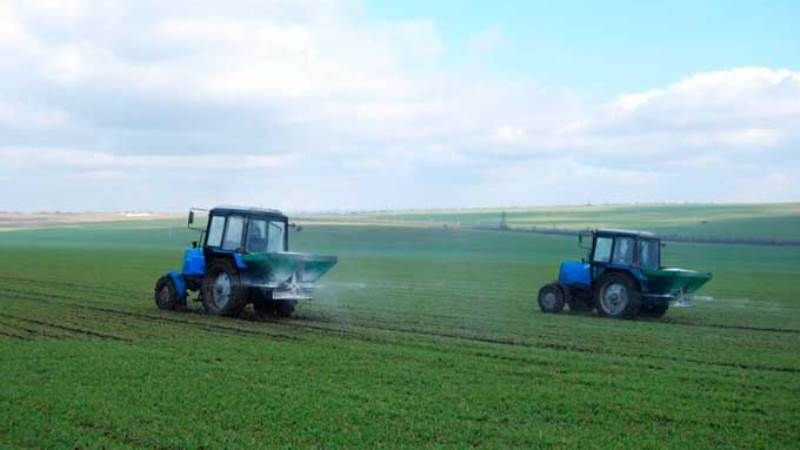What is good about nitrogen fertilization of winter wheat and how it is applied
Nitrogen starvation of wheat is a guarantee of loss of 30% of the crop. In order to prevent such a situation, the volume of the harvest is planned taking into account the needs of the cereal in nitrogen, and the lack of nutrition at each stage of development is compensated for by top dressing. The benefits and efficiency of work depend on the correct choice of fertilizer, calculation of the dosage and timeliness of actions.
The content of the article
Why winter wheat needs nitrogen fertilizers
Nitrogen is part of proteins - an essential element for plant growth and development. Photosynthesis cannot do without it, thanks to it, plants are actively gaining green mass and are fully formed. Winter wheat is very demanding on the soil. The lack of food will affect not only the volume of the harvest, but also the quality of the grain.

Problems with a deficiency of a substance are distinguished according to the phases of cereal development:
- tillering phase - stopping the formation of shoots;
- booting stage - stopping the laying of new spikelets;
- flag leaf phase - flowers do not form;
- grain filling stage - small grains of poor quality.
Clear signs of nitrogen starvation are a signal that part of the crop has already been lost. Such problems will not arise if you calculate the amount of the required substance and apply mineral dressing on time. Winter wheat forms the yield at each growth phase.
Therefore, the effectiveness of fertilizers depends on several factors:
- Time. The ideal time for feeding is when the culture wakes up, does not yet need nitrogen, but is already able to accept and use it.
- Phase calculation. Each stage of development has its own nitrogen rate. A deficiency at the tillering stage is not compensated by an overabundance at the booting stage - the plant's potential will decrease, and some of the fertilizers will be wasted.
- Fertilizer form. The choice of the nitrogen form and the method of feeding depends on the phase of development of the cereal and the state of the soil.
Against the background of a general decline in the fertility of the earth, such top dressing becomes for wheat measure of the first necessity.
Types of nitrogen fertilizers for wheat

Dry nitrogen-containing products are produced in the form of powders, crystalline and granular mixtures that are highly hygroscopic. They dissolve quickly in water and are comfortable to work with. However, such compositions are demanding on storage conditions - in unfavorable conditions they lose flowability and stick together into large lumps. Storage rules for each type are indicated on the packages.
Reference! Against the background of the entire assortment, the highest risk of caking is in calcium and ammonium nitrate, and the most stable in storage is ammonium sulfate.
Fertilizers are grouped according to nitrogen forms:
- ammonia group (ammonium sulfate);
- ammonium nitrate (ammonium nitrate, calcium ammonium nitrate);
- nitrate (sodium nitrate);
- amide - urea (carbamide).
Ammonium sulfate withContains 21% nitrogen and 24% sulfur. The fertilizer is well stored and does not cake. It is a quick-access and sedentary form, therefore it is suitable for autumn and spring. Suitable for main food and as a top dressing. Cannot be mixed with alkaline products.
Ammonium nitrate with "B" grade - fine-crystalline powder with additions of calcium, magnesium, sulfate and 34% nitrogen content. Universal fertilizer with 2 element forms suitable for all types of soils and different application times. Ammonium nitrate stimulates wheat growth, despite the cold and frozen ground. Nitrogen forms are not washed out from the soil. Apply the agent for sowing and for feeding.Differs in high demands on storage conditions.
Attention! Ammonium nitrate is explosive. It is important to follow the storage rules and safety measures when working with the material.
Lime-ammonium nitrate contains 26% nitrogen, calcium and magnesium. This complex fertilizer of complex action does not acidify the soil and is well suited for alkaline soils. Introduced in spring and autumn as a basis, used as a top dressing during the growing season of plants.
Sodium nitrate - alkaline composition, which contains 16% of the element. Easy to digest and suitable for acidic soils. Due to the quick washout, it is not used in the fall. For winter wheat, it is used as a nitrogen supplement.
Urea non-toxic, contains 46% nitrogen. The granulated mixture keeps well. Due to the movable form of the element, it is not suitable for autumn embedding. The fertilizer does not burn the leaves, therefore it is used for foliar feeding.
UAN (carbamide-ammonia mixture) - liquid fertilizer containing 32% nitrogen. Suitable for embedding in soil and as leaf feed.
All formulations are readily soluble in water, but require increased attention to storage conditions.
It is interesting:
When is it necessary to feed cucumbers with urea and how to apply it correctly.
Feeding tomatoes with urea: why is it needed and how to do it.
Application methods
The winter wheat yield directly depends on the amount of nitrogen that the plant assimilates. In addition to the pre-sowing fertilization, the cereal requires proper systemic feeding. It is carried out in two ways:
- Root - the main and mandatory method in which one-component or complex fertilizers are applied to the soil. When choosing a product, take into account the quality of the soil, the percentage of moisture, weather conditions and the stage of development of wheat.
- Foliar or leafy - an additional fast way of feeding through the leaves. To avoid burns, plants are treated in the morning, evening or night, when temperature not higher than + 20 ° C and taking into account sufficient humidity. For foliar feeding, a urea solution is suitable.
Urea combines well with magnesium sulfate, increases the effectiveness of insecticides and fungicides.
Terms of introduction
According to the phases of the growing season, cereals assimilate nitrogen in a certain dynamics:
- germination - 8%;
- tillering - 28%;
- booting - 36%;
- heading out / flowering - 12%;
- ripening of grain - 16%.
The maximum effect is given not by one-time, but by fractional feeding. The main part is brought in in the autumn-spring period, the remainder - during the growing season, before the beginning of grain filling.
For autumn feeding, 20% of the total amount of nitrogen fertilizers is allocated. It is carried out with the onset of cold weather, at a temperature of about + 10 ° C. Under such conditions, the soil biota no longer works and nitrogen is well fixed in the soil.
The first early spring top dressing is carried out on frozen-thawed soil with a fertilizer consumption of 40% of the total weight. This will help the cereal to wake up and start growing faster than the weed. Ammonium sulfate, CAS, or ammonium nitrate are optimal.
The second spring feeding is given during the tillering period. It is 30% of the general rate. At that time wheat responds well to ammonium sulfate. Another 5-6% is added in the booting phase. The remainder goes for additional leaf feeding with a solution of urea with pesticides and fungicides.
Standards

The total amount of nitrogen fertilizers and the optimal way of using them are selected individually. The lack of a substance affects the productivity of the crop, and an excess can change the state of the soil. The calculation of the rate depends on the plans for the volume of the harvest. For 1 ton of grain, wheat requires 20-25 kg of nitrogen. Accordingly, for a harvest of 5 t / ha, about 100 kg of fertilizing will be required. This is the amount of active ingredient for the entire growing season.
Important! Calculations are adjusted for the predecessor crop, nitrogen in the soil and early fertilization.For example, for a yield of 6 t / ha, taking into account all adjustments, from 100 to 150 kg / ha of top dressing is applied in stages.
The spring dose is adjusted according to the state of the crops:
- the density of the stalk exceeds 1000 pcs / m2 - fertilizers yield no more than 45 kg / ha, the remainder is added during the booting phase;
- stand density - from 800 to 1000 pcs./m2 - 50-60 kg / ha are applied;
- the stalk is thinned - the dose of fertilizers is increased by 25-30%.
Fractional feeding with nitrogen is fully absorbed, optimizes tillering, promotes the formation of strong straws and prevents wheat from lodging.
How winter wheat is fertilized

It is unrealistic to manually feed large fields: it will be a long and laborious process. There is a special technique for the procedure: fertilizer seeders, trailed fertilizer spreaders and mounted sprayers.
The technique is classified by purpose:
- for crushing caked fat (ISU-4);
- transportation trailers (RUM-8);
- sprayers of liquid formulations (PZHU-5, PZHU-9);
- spreaders of solid mineral fertilizers (RTT-4, NRU-0.5, 1-RMG-4);
- for feeding into the furrows (MLG-1).
Sequence of work:
- The dosage is calculated and fertilizers are prepared: crushed fat is crushed or liquid mixtures are made.
- They transport the finished material.
- With the help of machines, funds are introduced into the soil or sprayed. The width of the sprayer must match the tramline.

Common mistakes
At the initial growing season, winter wheat feeds only from the soil, but in the future, foliar feeding is also required. It is ineffective to use only one method of plant nutrition.
Frequent mistakes:
- Incorrect dosage - taking into account the area of the entire field, and not plantings, will lead to an excess of nitrogen.
- Wrong timing - needs do not depend on the calendar, but on the dynamics of development in the phases of the growing season.
- Increased concentration - oversaturated solution leads to leaf and root burns.
- Uneven foliar nutrition - It is important that the solution completely covers the aerial parts of the plants.
- "Infernal" mixture - a mix of incompatible mineral compounds that will give a toxic chemical reaction.
To make the food as productive as possible, soil analysis is regularly carried out, and mineral mixtures are prepared according to the manufacturers' instructions.
Conclusion
Winter wheat needs nitrogen throughout the growing season. The consequences of its lack are low yields, small grain of poor quality and even the death of plants. Systemic nitrogen feeding will help to avoid these problems. Fertilizers are introduced into the soil fractionally and in stages, according to the phases of the development of the cereal, and fed by the foliar method. The dosage depends on the condition of the soil and plans for the volume of the crop.